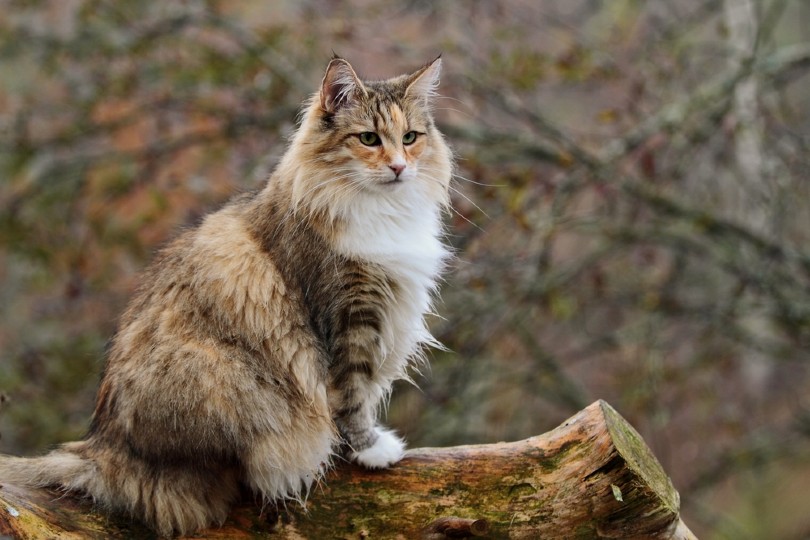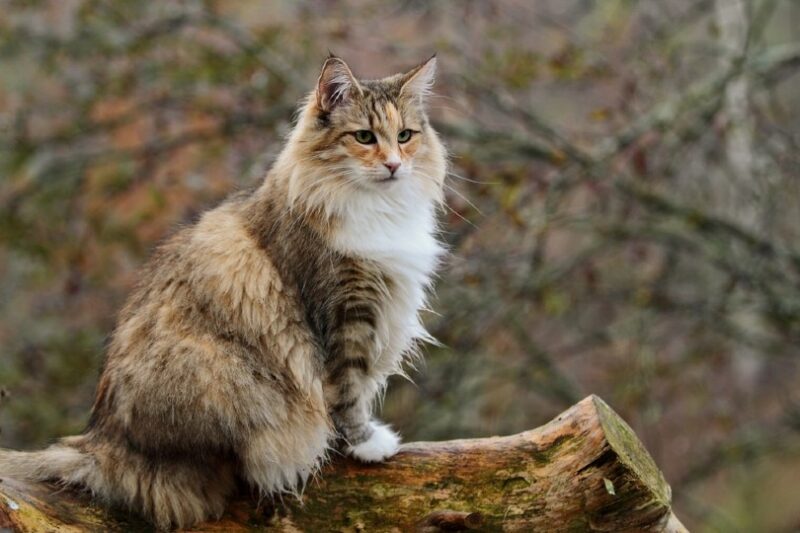Click to Skip Ahead
If you’ve ever met a Norwegian Forest Cat, you already know that these magnificent cats are large, powerful, and full of personality. What you might not know about them is that they can be found in almost any color and pattern that you can imagine! While tabby might be the classic color that springs to mind when many of us think about this breed, you can find them in a rainbow of other shades too.
Unless otherwise noted, the eyes of a Norwegian Forest Cat will be shades of copper, green-gold, gold, or green. Cats with a large amount of white may have blue or odd-colored eyes. The paw pads and nose leather can be almost any color or combination of colors, and these aren’t linked to coat color unless specifically noted. Some colors are more desirable than others, though. Cats with white feet can either have pink, bi-, or multi-colored paw pads.
Now, let’s dive into all these gorgeous colors! For reference, we’ve used the breed standard from the Cat Fanciers Association.
Norwegian Forest Cat Colors Infographic
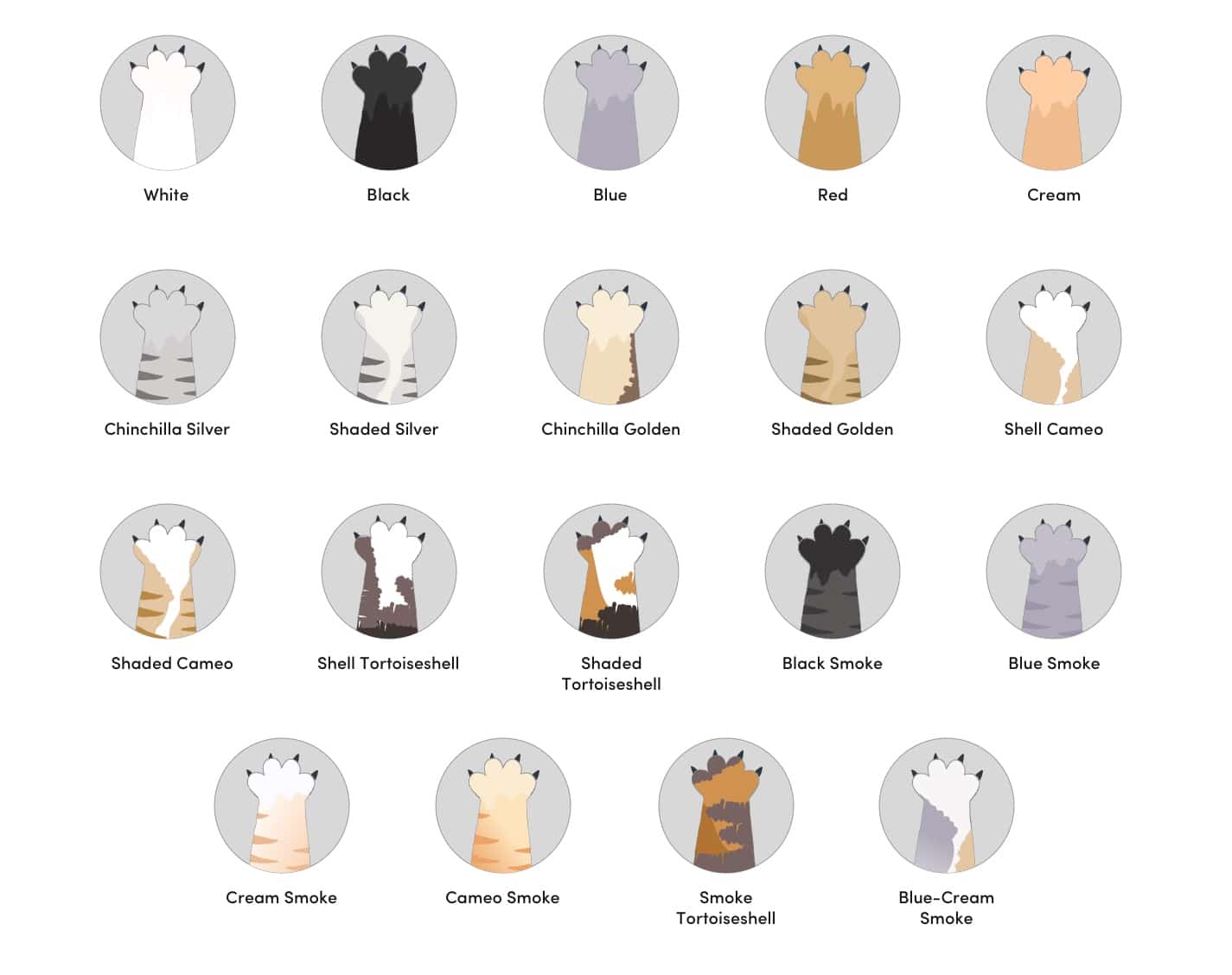
The 60 Norwegian Forest Cat Colors & Patterns
1. White Norwegian Forest Cat
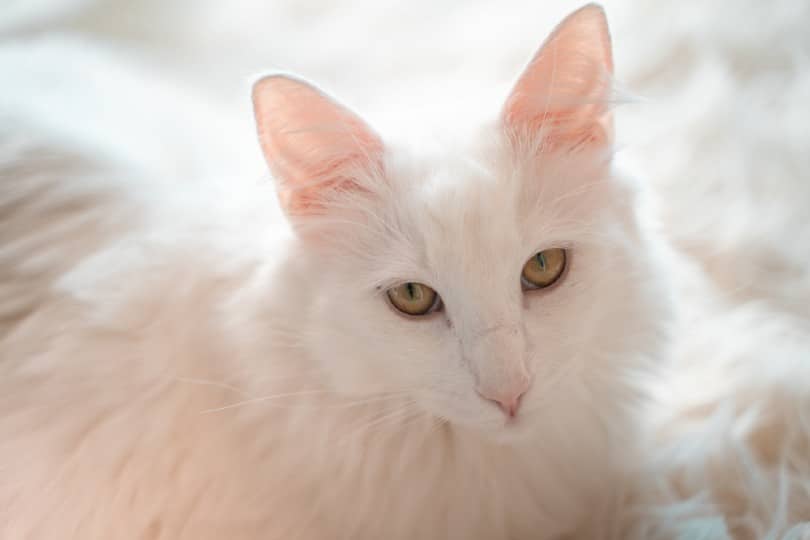
A white Norwegian Forest Cat is rare, so if you ever come across one, they’re quite a sight to behold! White Norwegian Forest Cats actually don’t have any pigment in their hair at all, so it should look glistening and glacial. They will have pink paw pads and nose leather. Often, these cats will have blue eyes. White cats are frequently deaf or have varying levels of hearing loss, but this shouldn’t cause any problems once you know how to manage it.
2. Black Norwegian Forest Cat
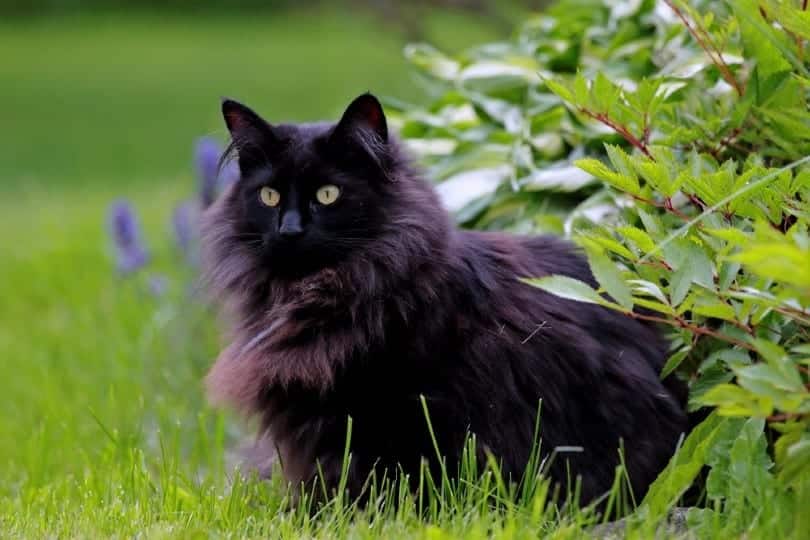
Black Norwegian Forest Cats will have coats of a deep coal black, with the same color running from root to tip. Preferably, they should have black paw pads and nose leather.
3. Blue Grey Norwegian Forest Cat
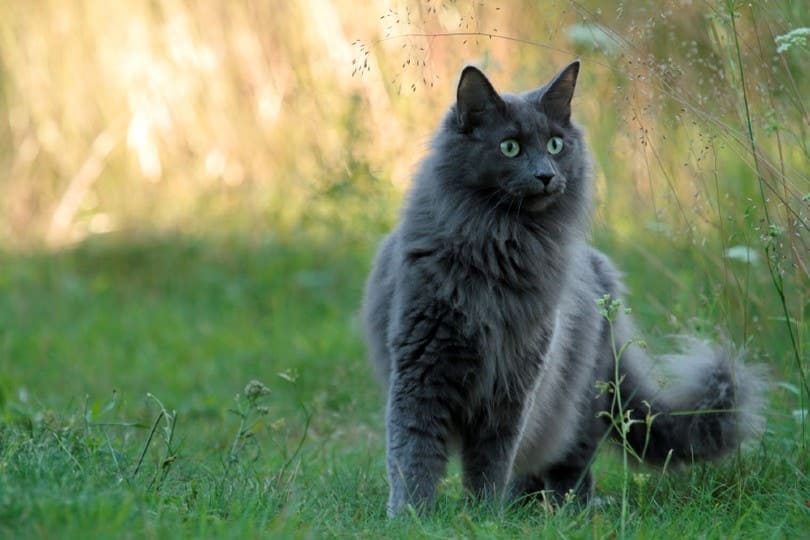
A blue Norwegian Forest Cat has one equal tone of blue across the entire body. The color should be the same from the root of each hair all the way to the tip. Blue is, in fact, a diluted version of black, with an additional gene that creates the faded coloration. Blue paw pads and noses are desirable.
4. Red Norwegian Forest Cat
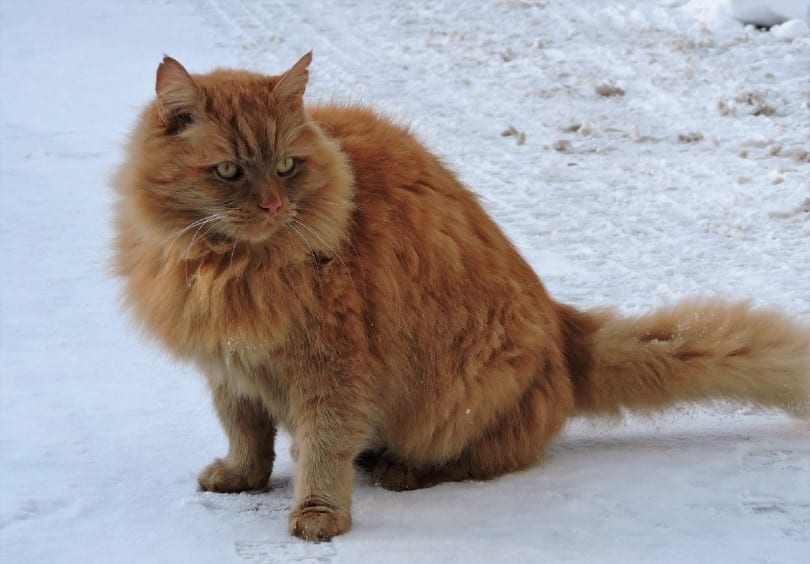
The red coat is what is commonly referred to as orange or ginger. These cats can have red coats in a range of shades, from flaming red to a pale peach. Their coats should have no markings, shading, or ticking. Brick-red paw pads and nose leather are preferred.
5. Cream Norwegian Forest Cat
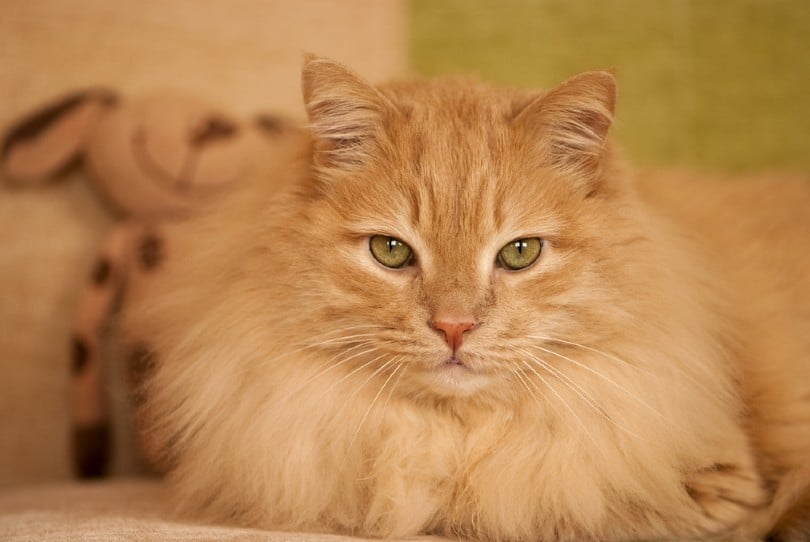
A cream Norwegian Forest Cat will have a coat in one shade of buff cream, without any darker markings. Lighter shades are preferred, and the color should run true from the root to the tip of the hair. Cream is a diluted form of the red coat. Pink paw pads and noses are preferable to any other shade.
6. Chinchilla Silver Norwegian Forest Cat
A chinchilla silver Norwegian Forest Cat has a pure white undercoat, with black tips across the back, sides, head, and tail. As the cat moves, the coat has a shimmering silver effect. The legs can have a lighter shade of tipping, but the chin, stomach, chest, and ear tufts should remain pure white. A nose leather of brick red is preferred, combined with black paw pads.
7. Shaded Silver Norwegian Forest Cat
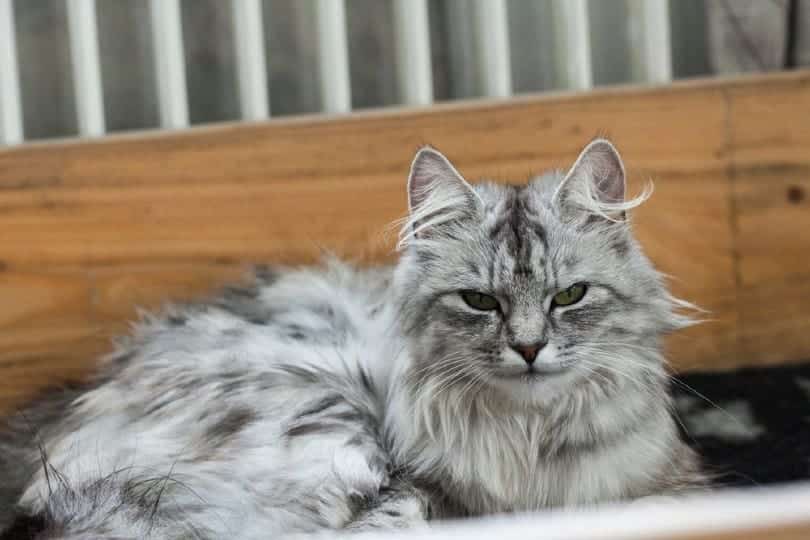
Shaded silver Norwegian Forest Cats have an undercoat of glacial white, with significant black tipping across their back, flanks, head, and tail. The darkest area should be across the spine, moving to paler shades, then into white on the chin, stomach, chest, and under the tail. Black paw pads and brick-red nose leather are preferred.
8. Chinchilla Golden Norwegian Forest Cat
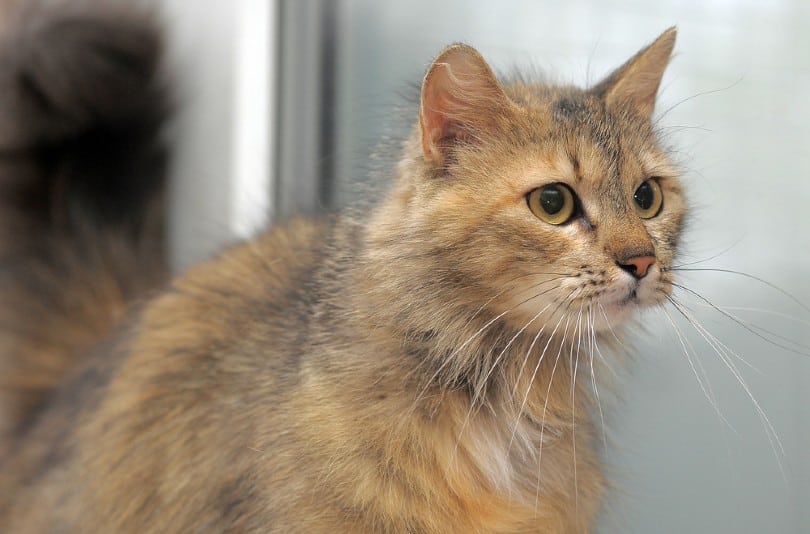
These Norwegian Forest Cats will have an undercoat of rich cream, with warm tones. This is overlaid with black tipping across the head, tail, back, and sides. The chest, stomach, ear tufts, and chin should remain cream. Deep rose nose leather and black paw pads are desirable above other shades.
9. Shaded Golden Norwegian Forest Cat
A shaded golden Norwegian Forest Cat has an undercoat of warm cream, with a considerable amount of black tipping, far more than the chinchilla golden coat color. The ridge of the spine should be the darkest area, and the chin, chest, and stomach should all be cream only. Black paw pads and a deep rose nose leather are preferable.
10. Shell Cameo Norwegian Forest Cat
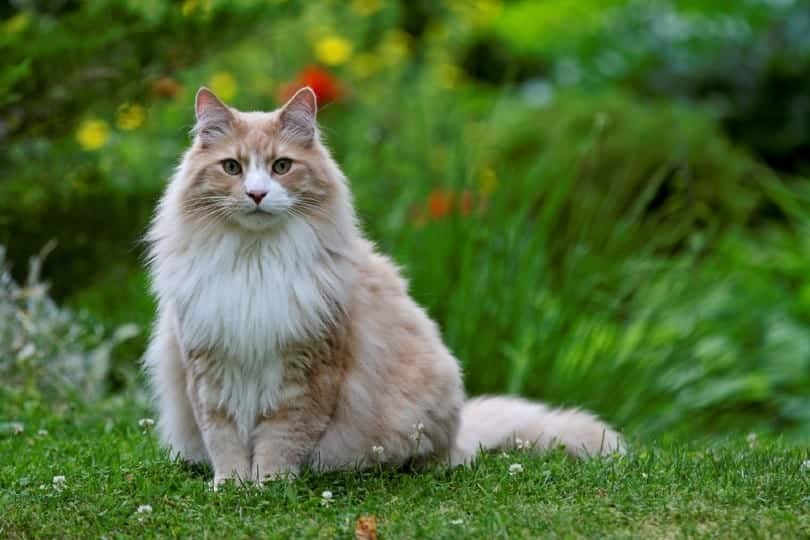
Also known as red chinchilla, this shade of Norwegian Forest Cat has a white undercoat with red tips across the head, tail, back, and flanks. This gives the characteristic shimmering effect seen in all cats with the chinchilla coat. The face and legs may be lightly tipped, but the chest, stomach, ear tufts, and chin should be white. Rose paw pads and nose leather are preferred.
11. Shaded Cameo Norwegian Forest Cat
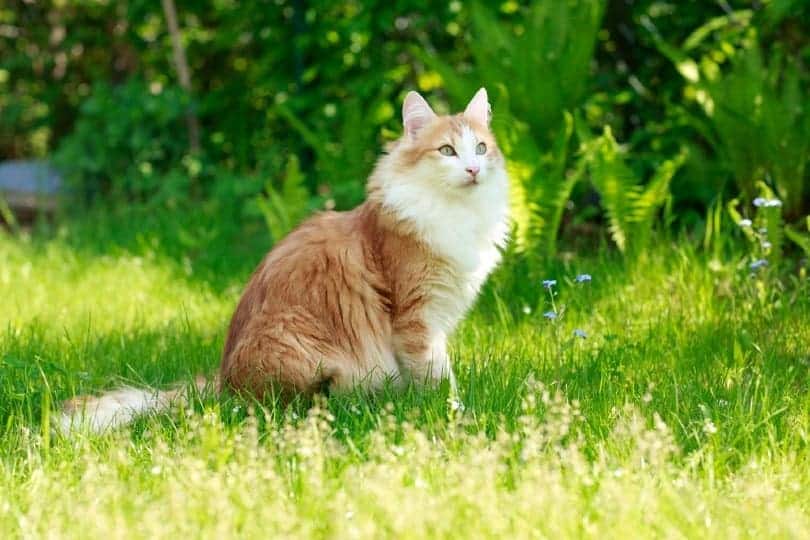
A shaded cameo Norwegian Forest Cat is also sometimes called a red shaded. These cats have a white undercoat with a significant amount of red tipping over the flanks, face, and tail. The fur along the spine will be the darkest red, fading to white on the chin, chest, and stomach. Rose-colored nose leather and paw pads are preferred.
12. Shell Tortoiseshell Norwegian Forest Cat
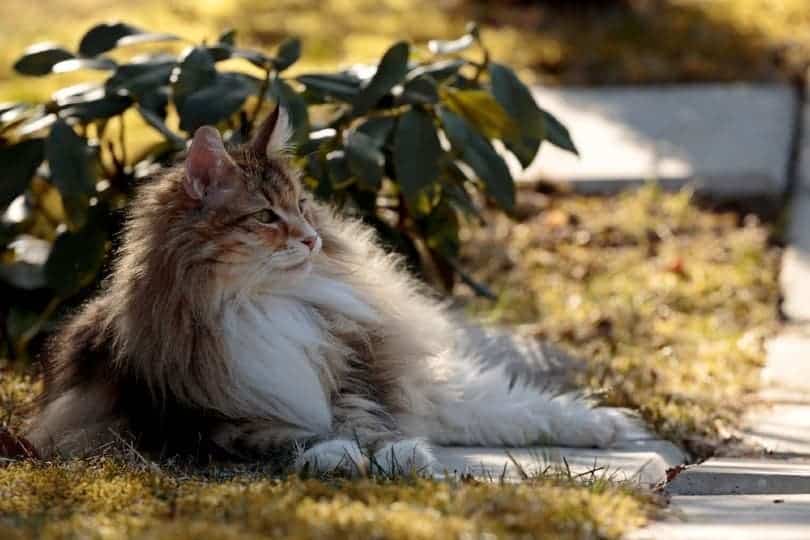
These Norwegian Forest Cats have a white undercoat, with tips of red, cream, and black across the flanks, tail, and head. The chin, chest, ear tufts, and stomach should be white. A cream or red blaze on the face is desirable.
13. Shaded Tortoiseshell Norwegian Forest Cat
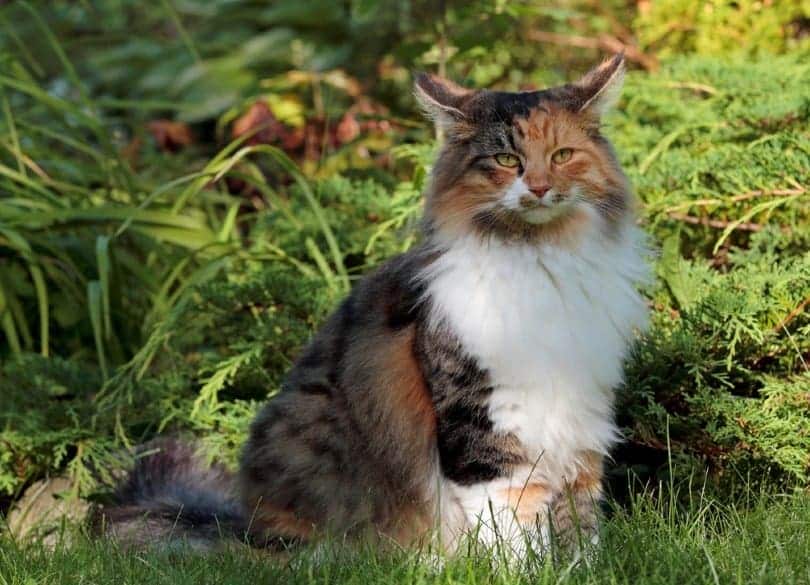
A shaded tortoiseshell Norwegian Forest Cat has a white undercoat, with a dense amount of tipping in black, and clearly defined patches of red and cream. Cats of show classes should preferably have a blaze of cream or red on their face.
14. Black Smoke Norwegian Forest Cat
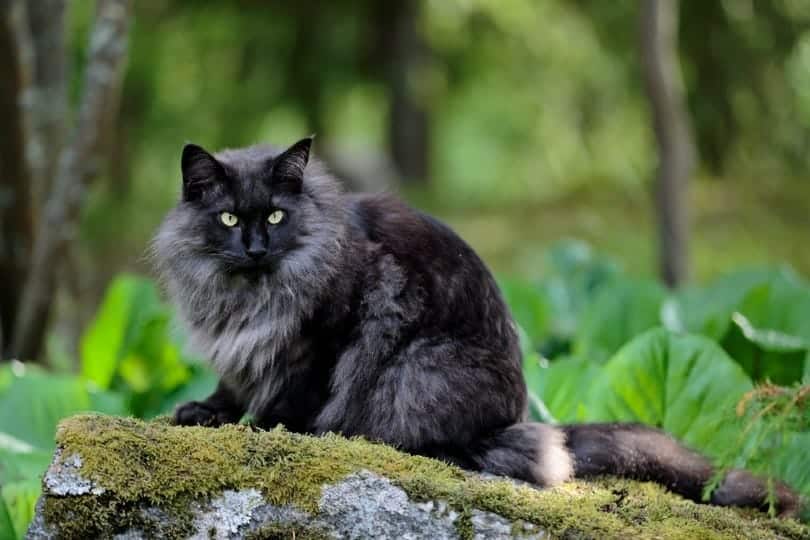
A black smoke Norwegian Forest Cat appears black when they are resting, and it’s only once they move that you can clearly see their white undercoat. Their points and mask should be black with only a small amount of white at the roots of the fur. They should have a pale silver neck frill and ear tufts. Black nose leather and paw pads are preferable.
15. Blue Smoke Norwegian Forest Cat
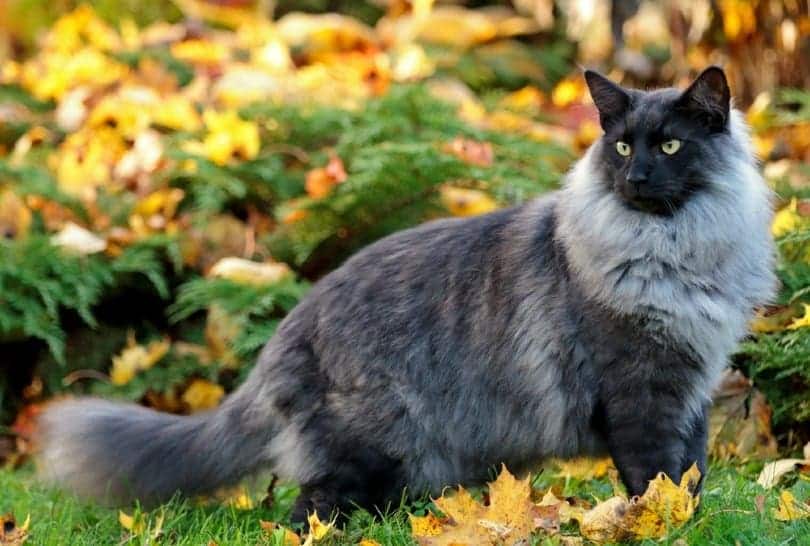
A blue smoke Norwegian Forest Cat appears blue, but they have a white undercoat that can be seen when they move. Their points and face will be blue, and they have a white frill and ear tufts. Their paw pads and nose leather should be blue.
16. Cream Smoke Norwegian Forest Cat
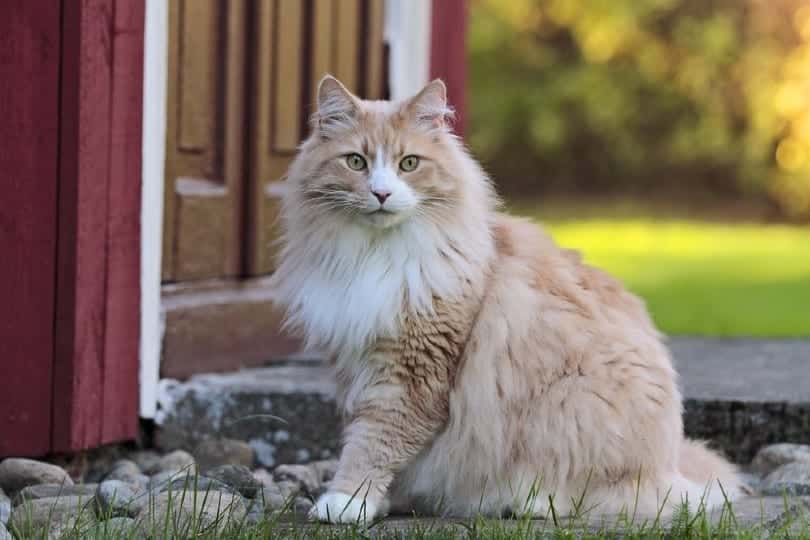
These Norwegian Forest Cats have a white undercoat with a deep amount of cream tipping. The undercoat shouldn’t be visible unless they’re moving. They will have a white frill and ear tufts, with cream points and mask. Their paw pads and nose leather should be pink.
17. Cameo Smoke Norwegian Forest Cat
A cameo smoke Norwegian Forest Cat is also sometimes called a red smoke. They have a white undercoat with a deep amount of red tipping. Their undercoat won’t be visible unless they’re moving. They will have a white frill and ear tufts, with red points and mask. Rose-pink paw pads and nose leather are desirable.
18. Smoke Tortoiseshell Norwegian Forest Cat
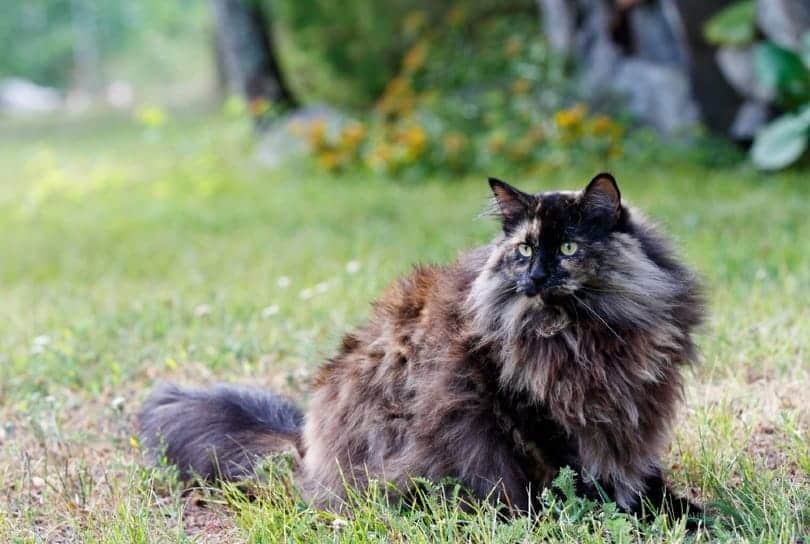
A smoke tortoiseshell Norwegian Forest Cat has a white undercoat, with a heavy amount of black tipping, as well as unbrindled patches of red and cream. They look similar to a tortoiseshell cat until they move and their undercoat can be seen. They have a white frill and ear tufts. A red or cream blaze on the face is desired.
19. Blue-Cream Smoke Norwegian Forest Cat
A blue-cream smoke Norwegian Forest Cat has a white undercoat with a significant amount of blue tipping. They will also have areas of cream markings. Their points and masks are blue cream, and their ear tufts and frills are white. A cream-tipped blaze on the face is desired for showing cats.
Tabby Norwegian Forest Cat Colors
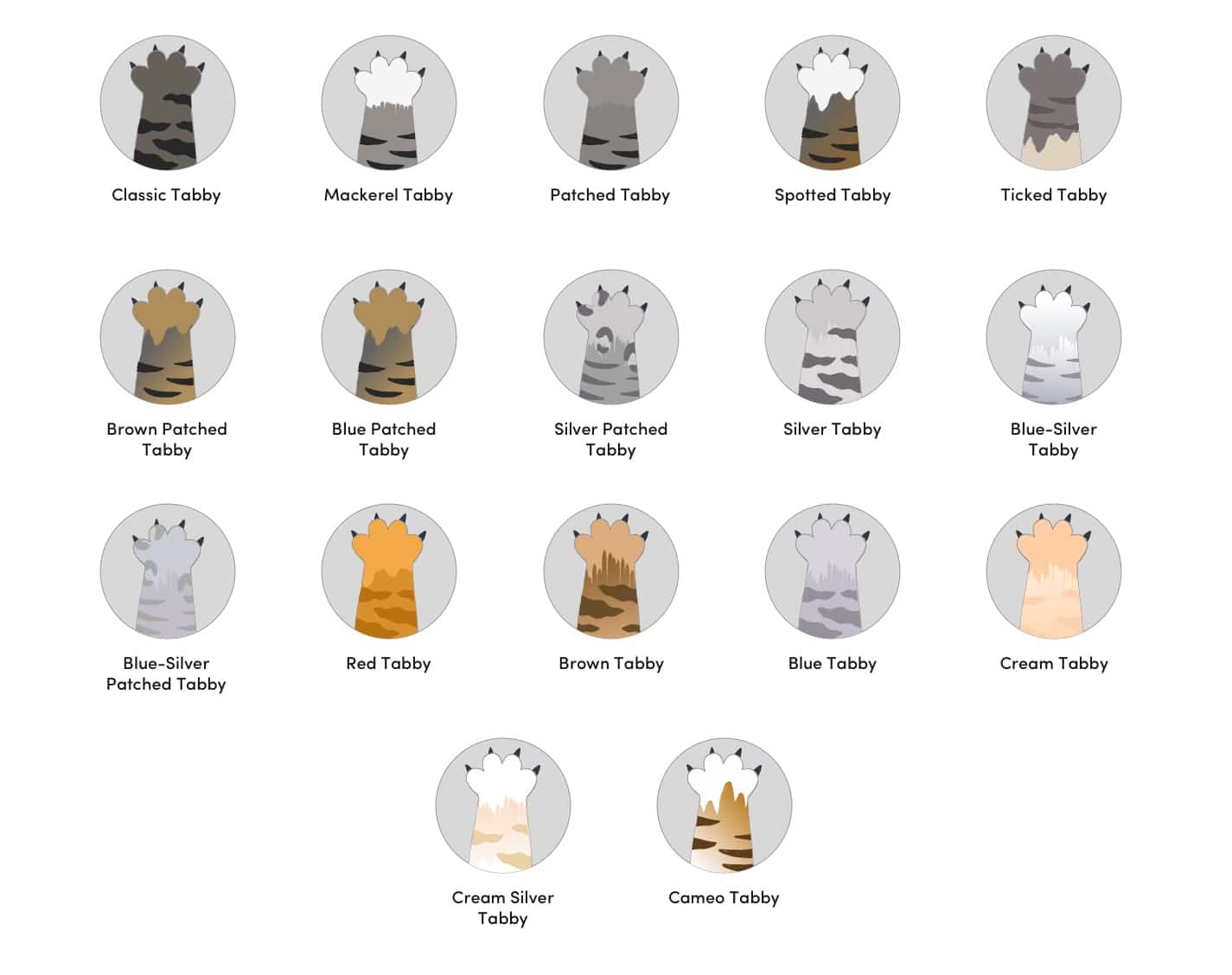
20. Classic Tabby Pattern Norwegian Forest Cat
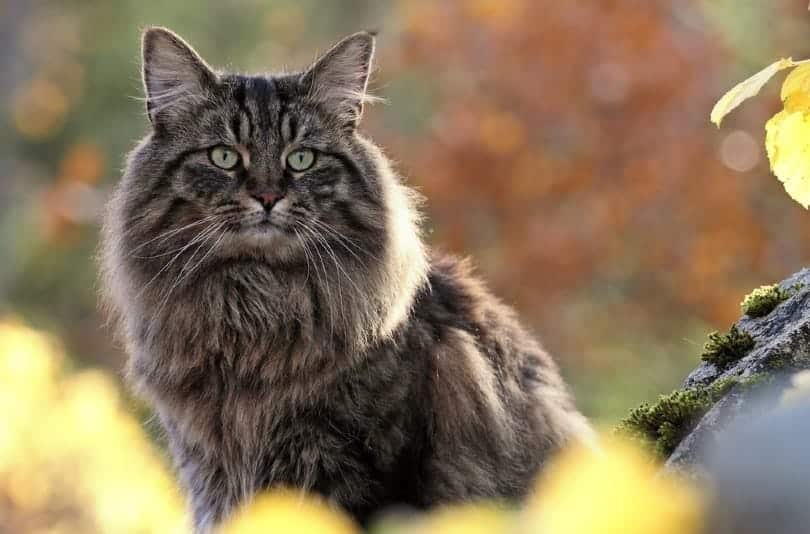
A Norwegian Forest Cat with the classic tabby pattern will have dense and clearly defined markings, including an “M” on their forehead, cheek swirls, and a vertical black line down their spines. Their tail will have even rings, and they will have a “butterfly” marking across their shoulders. Side markings should be symmetrical, and they should have a double vertical row of darker “button” or “locket” markings on the chest and stomach. White buttons are allowed.
21. Mackerel Tabby Pattern Norwegian Forest Cat
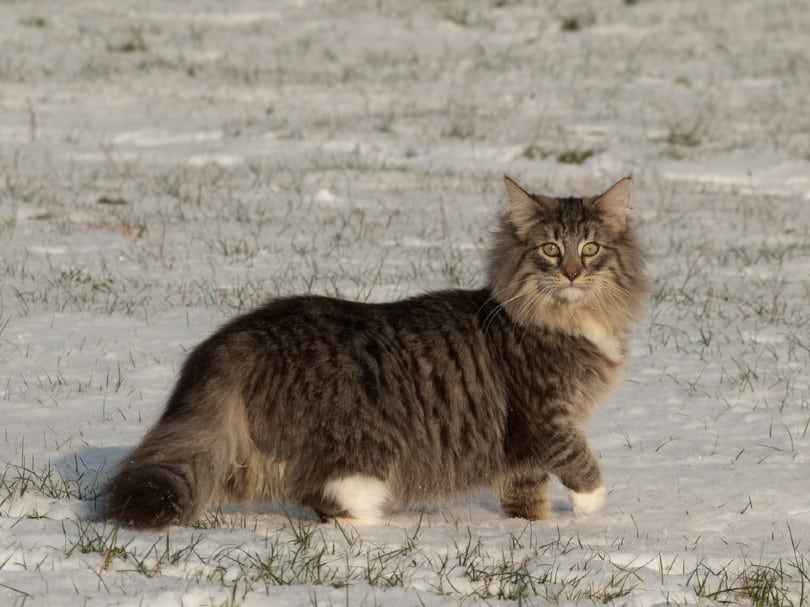
A mackerel tabby has narrow pencil markings, including leg barring, tail barring, and necklaces on the neck and chest. Their head should have an “M” on the forehead, with unbroken lines running from their eyes to meet their shoulders. The lines across their spine should run together to create a narrow saddle. They will have narrow pencil markings along their bodies. They can have white buttons or lockets.
22. Patched Tabby Pattern Norwegian Forest Cat
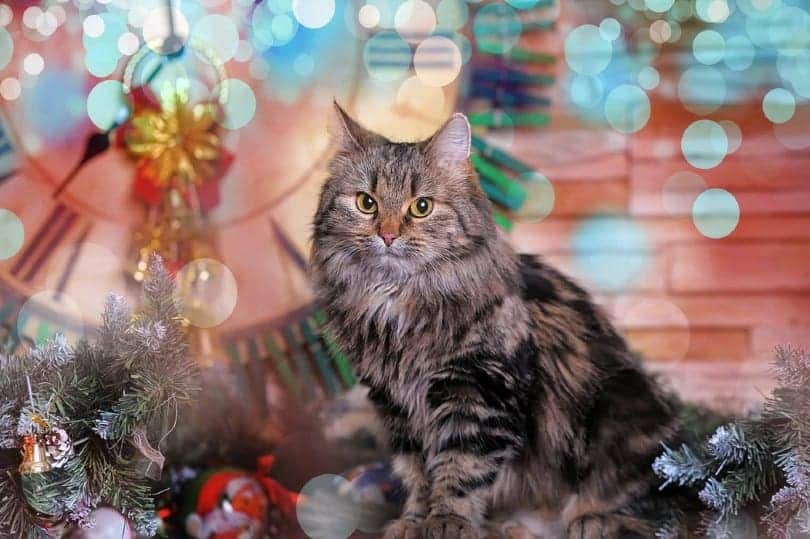
A patched tabby may also be called a tortie. They are tabbies in silver, brown, blue, or blue-silver, but they will also have clear patches of red, cream, or both red and cream. They can have white buttons or lockets.
23. Spotted Tabby Norwegian Forest Cat
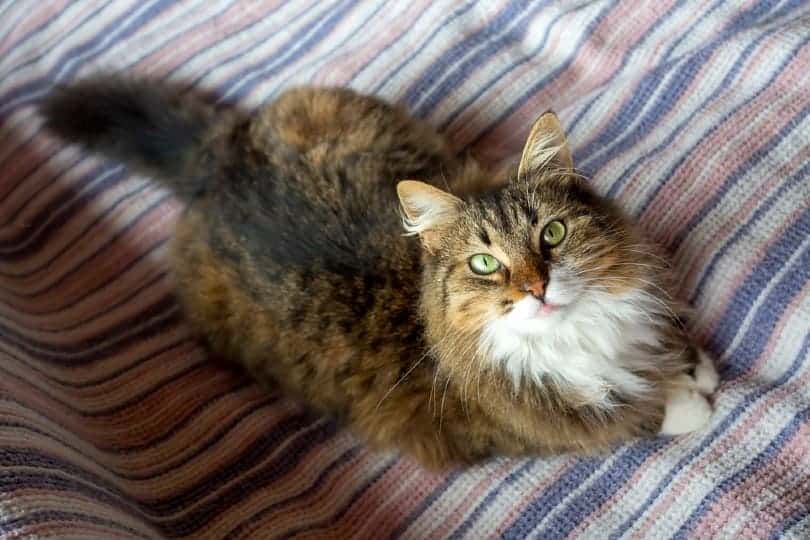
A spotted tabby Norwegian Forest Cat will have darker spots across their body, with preference given to evenly distributed, round spots. The stripe along their spine should also be spotted. Their facial markings are classic tabby markings, and their legs and tails are barred. Their stomachs have button markings, which can be white. They can also have a white locket.
24. Ticked Tabby Pattern Norwegian Forest Cat
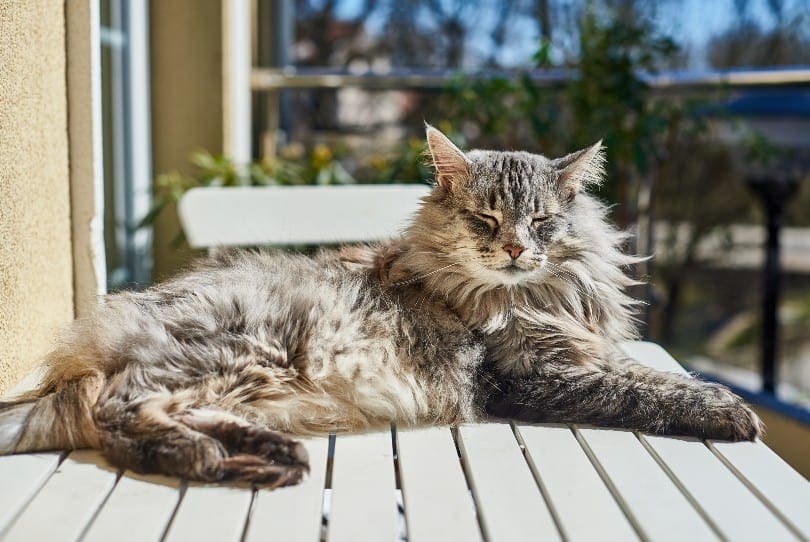
The ticked tabby pattern has ticked body hairs with shades in both the ground coat color and the marking color. The body should be free from spots, stripes, or blotches, but the face, tail, and legs should show distinct tabby markings. They can have white lockets or buttons.
25. Brown Patched Tabby Norwegian Forest Cat
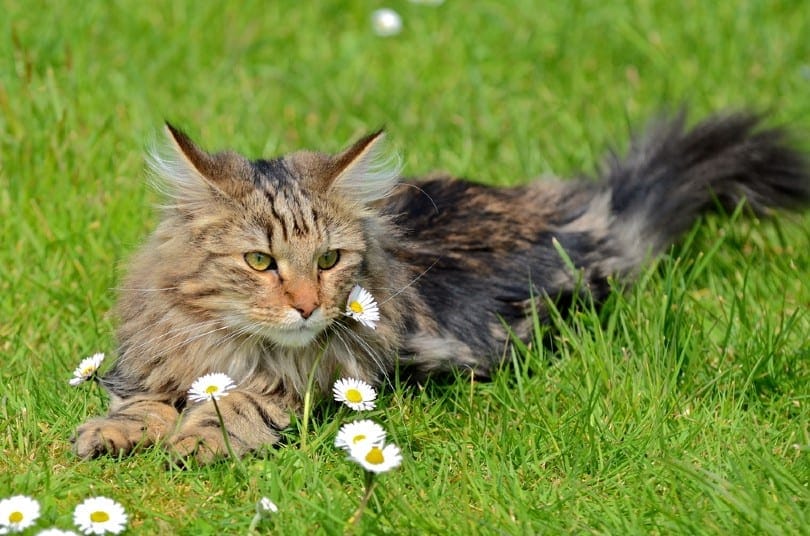
Brown patched tabbies will have a ground coat color in a coppery brown, with either classic or mackerel tabby markings in black. They will also have patches of red, cream, or both. Show cats should have a blaze of red or cream.
26. Blue Patched Tabby Norwegian Forest Cat
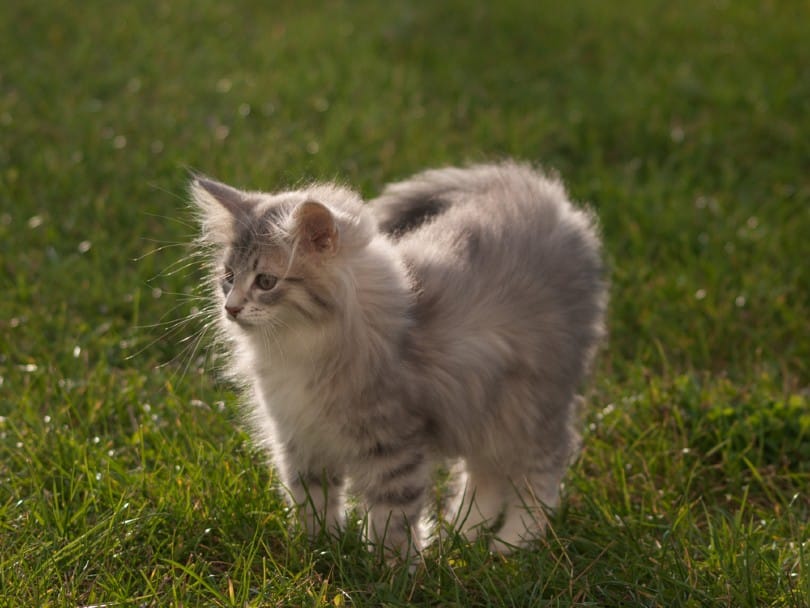
The blue patched tabby Norwegian Forest Cat has a ground color of pale ivory with a blue tone, overlaid with classic or mackerel tabby markings in deep blue. They will also have clear patches of cream over their bodies and extremities. A cream facial blaze is desirable. There should be an overall tone of warm fawn across the entire body.
27. Silver Patched Tabby Norwegian Forest Cat
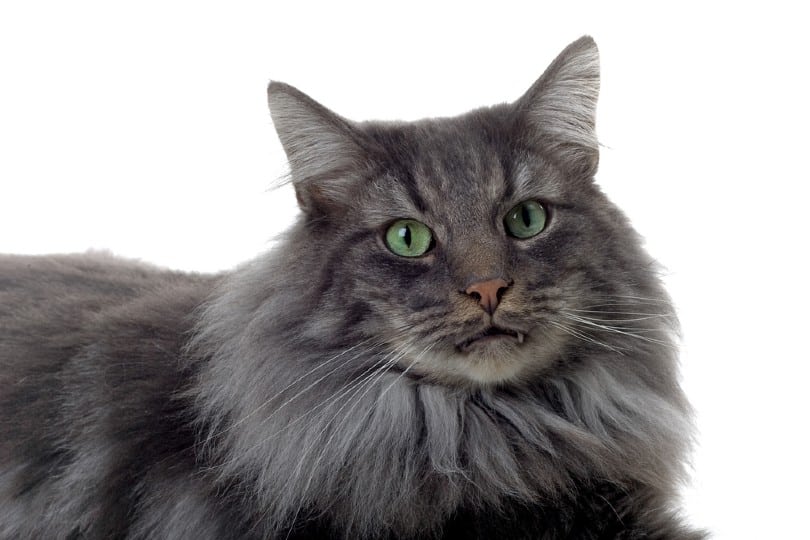
Silver patched tabbies have a pale silver ground color, with dense black markings in either the classic or mackerel pattern. They will also have patches of red, cream, or both. A blaze of cream or red is preferred.
28. Silver Tabby Norwegian Forest Cat
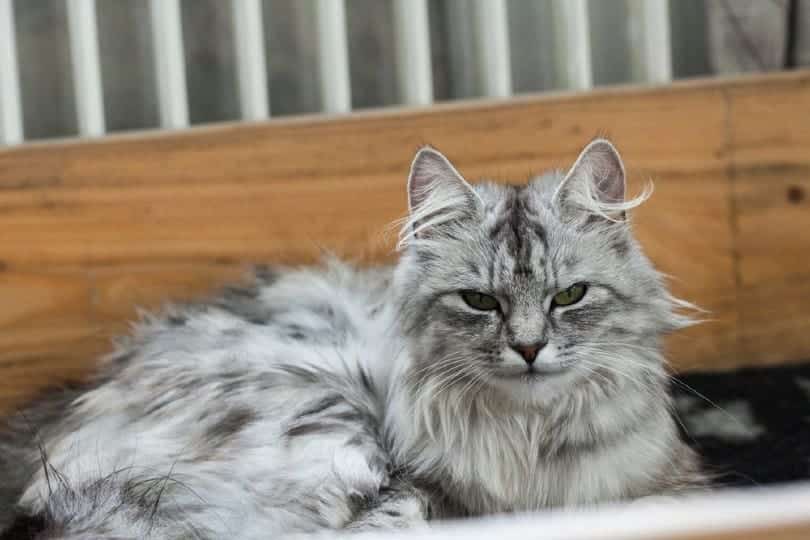
Silver tabbies can be classic, mackerel, ticked, or spotted. Their ground color will be a pale silver and their tabby markings are dense black. Brick-red nose leather and black paw pads are preferred.
29. Blue-Silver Tabby Norwegian Forest Cat
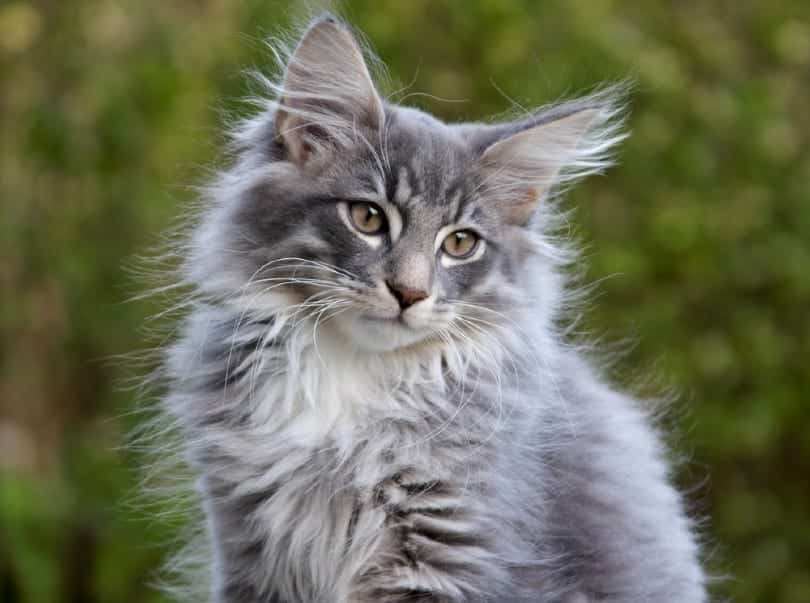
A blue-silver tabby Norwegian Forest Cat has a clear silver ground color with deep blue markings in either the classic, mackerel, ticked, or spotted patterns. They can have a white trim around their chin and lips. Old rose nose leather and rose paw pads are preferred.
30. Blue-Silver Patched Tabby Norwegian Forest Cat
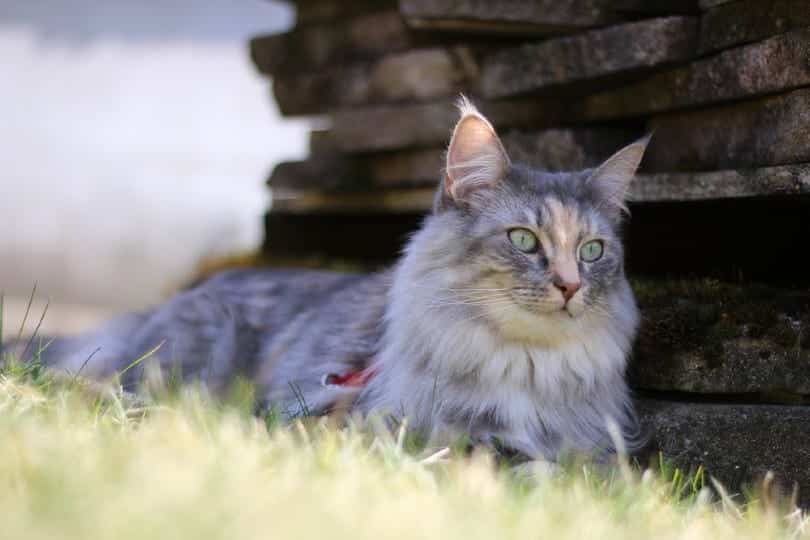
A blue-silver patched tabby has a silver ground color, black tabby markings (in classic, mackerel, ticked, or spotted), and clearly defined patches of cream. They can have a cream blaze on their faces and white trim on their chin and lips.
31. Red Tabby Norwegian Forest Cat
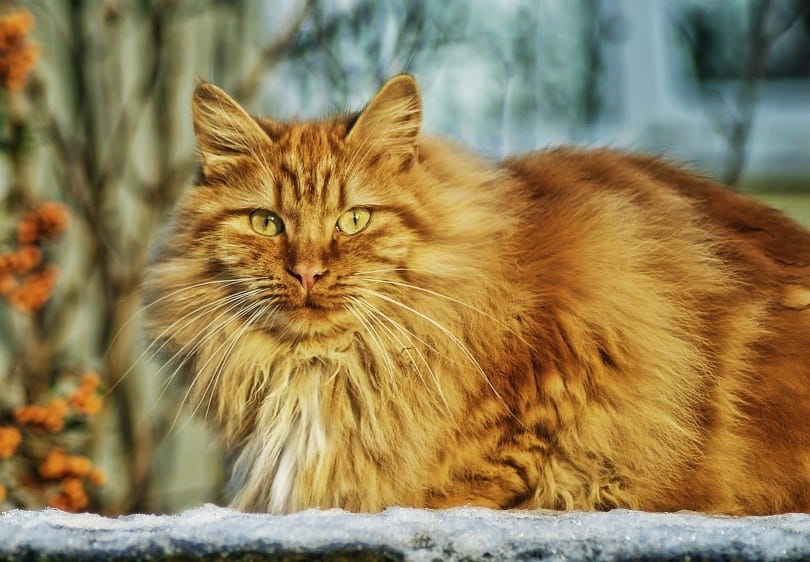
Red tabby Norwegian Forest Cats have a red ground color with tabby markings in a rich and deep shade of red. They can have tabby markings in any of the four patterns. Brick-red nose leather and paw pads are preferred.
32. Brown Tabby Norwegian Forest Cat
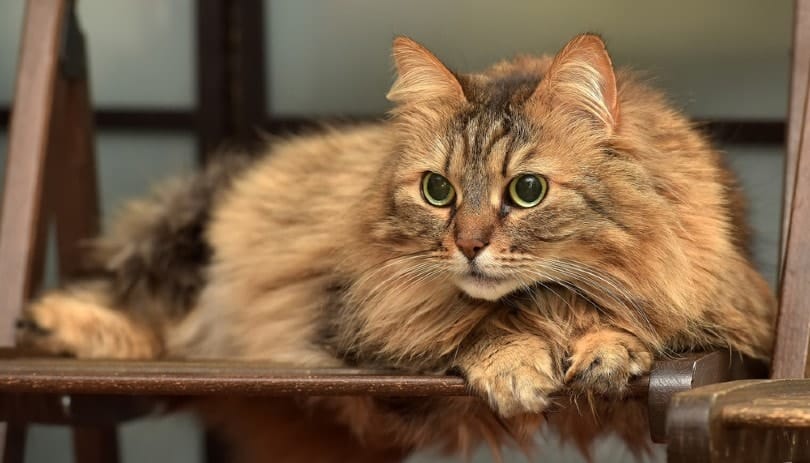
Brown tabbies have a copper-brown ground color with markings of any of the four tabby patterns in a dense black. The backs of their legs, from paw to heel, should also be black. Nose leather and paw pads in brown or black are preferred.
33. Blue Tabby Norwegian Forest Cat
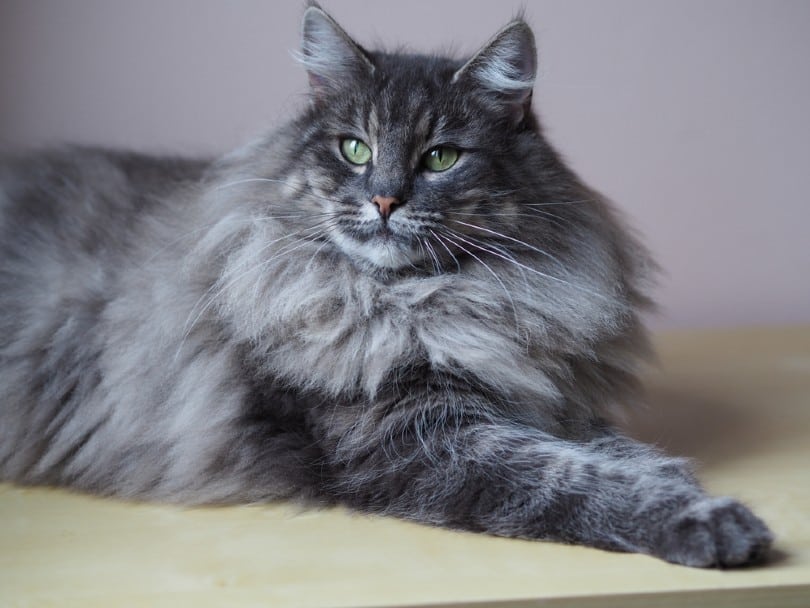
Blue tabby Norwegian Forest Cats have deep blue markings that can be either classic, spotted, ticked, or mackerel. Their ground color is a pale blue-ivory color. Their nose leather and paw pads are preferably rose colored.
34. Cream Tabby Norwegian Forest Cat
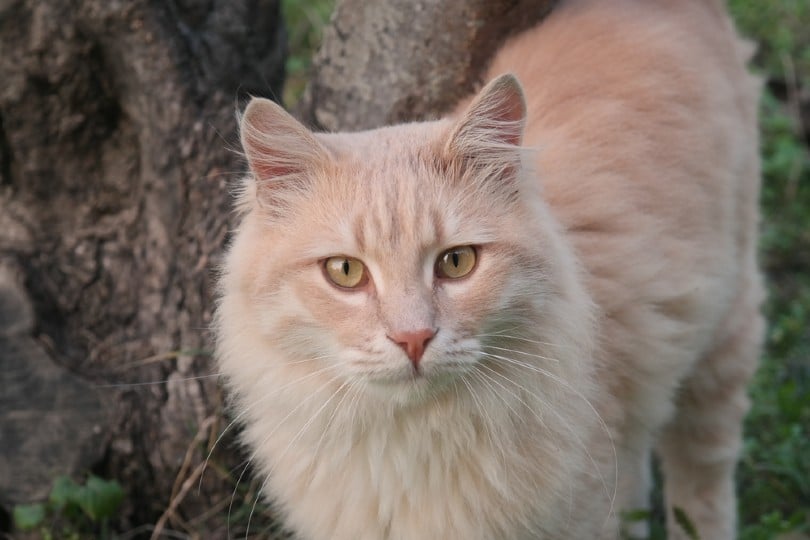
Cream tabbies have a pale cream ground color, with tabby markings in a darker cream but still a diluted shade. They can have the classic, spotted, ticked, or mackerel tabby pattern. Pink nose leather and paw pads are preferred.
35. Cream Silver Tabby Norwegian Forest Cat
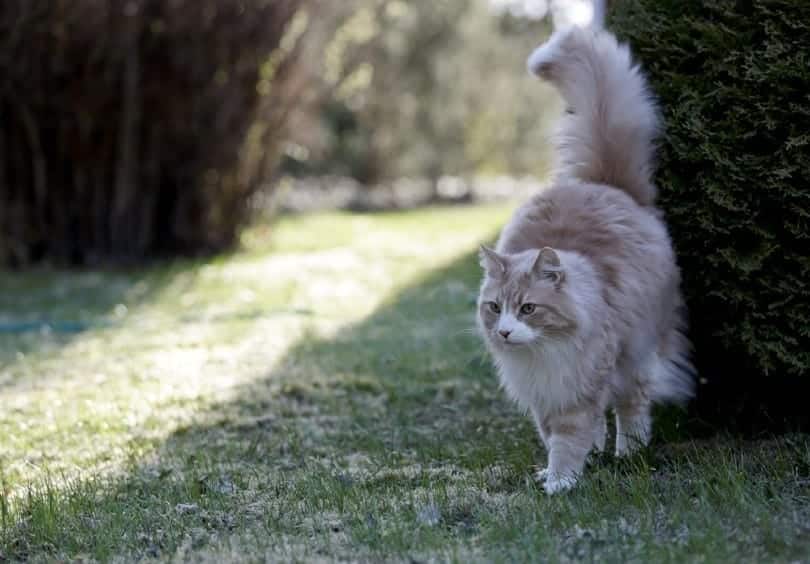
These Norwegian Forest Cats have a white undercoat, with tabby markings in cream. They should have pink paw pads and nose leather. Their tabby markings can be any one of the four main patterns.
36. Cameo Tabby Norwegian Forest Cat
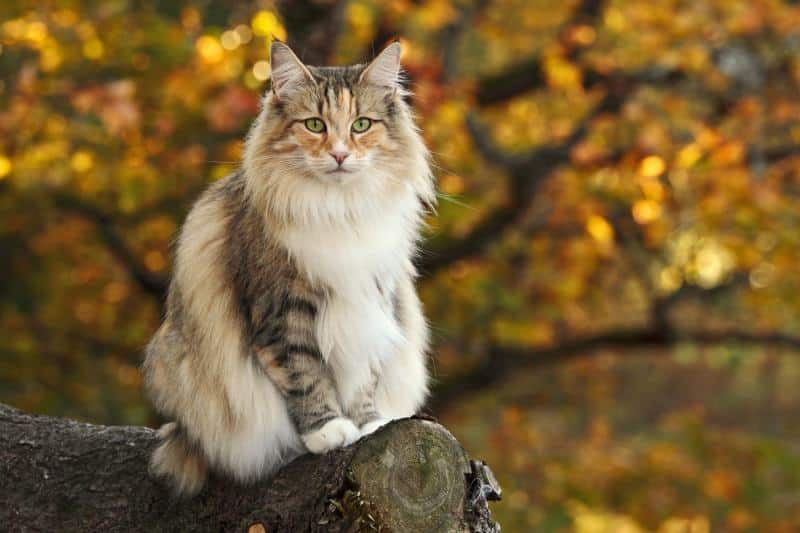
A cameo tabby has red markings across a white undercoat. Their nose leather and paw pads are preferably pink. Their tabby markings can be mackerel, classic, ticked, or spotted.
Norwegian Forest Cat Calico Patterns
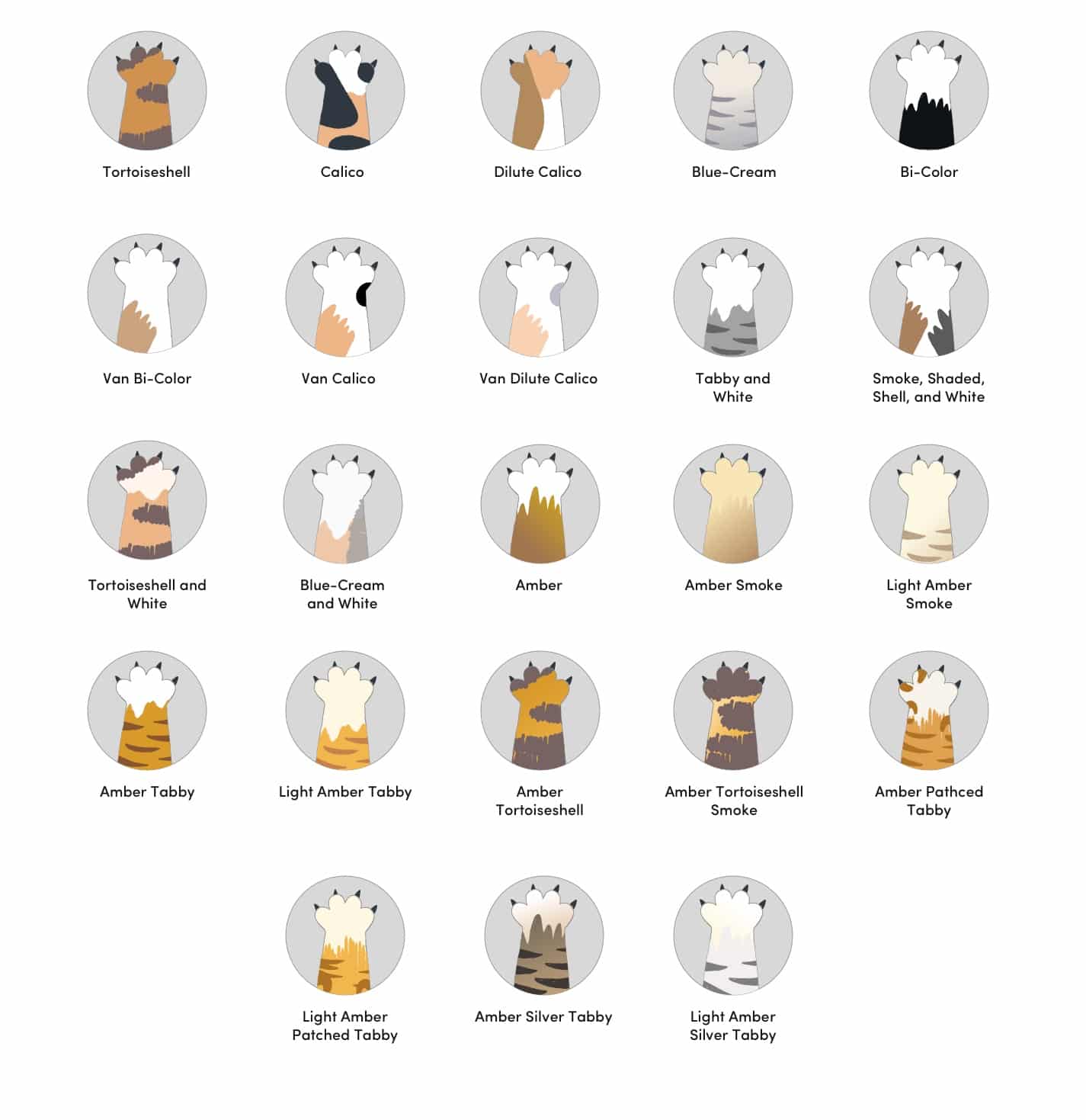
37. Tortoiseshell Norwegian Forest Cat
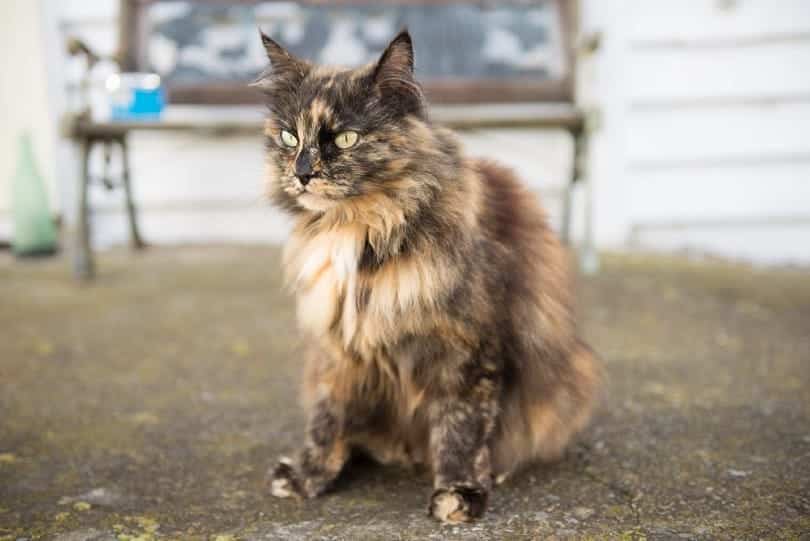
A tortoiseshell Norwegian Forest Cat has a black coat, interspersed with patches of red, which can be several different shades. The red should extend over both their bodies and extremities.
38. Calico Norwegian Forest Cat
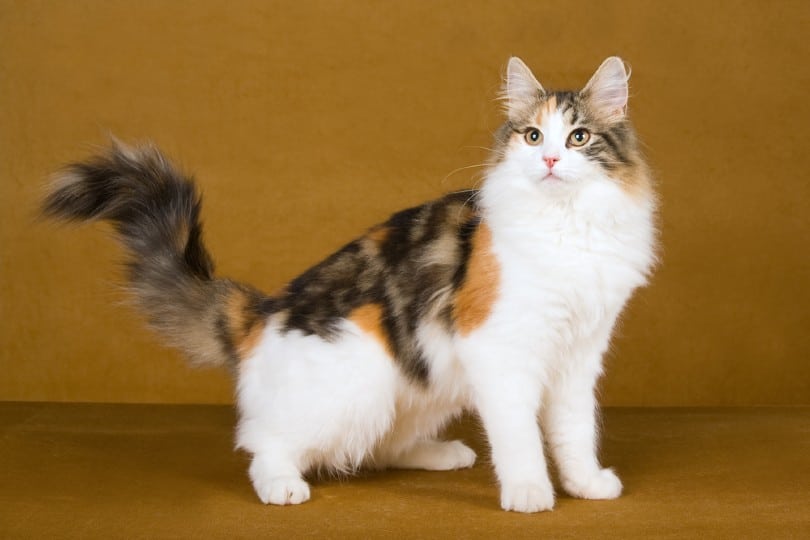
A calico Norwegian Forest Cat has a white coat, with patches of black and red. At a minimum, their feet, legs, chest, muzzle, and stomach should be white. An inverted “V” blaze on their faces is preferred for show cats.
39. Dilute Calico Norwegian Forest Cat
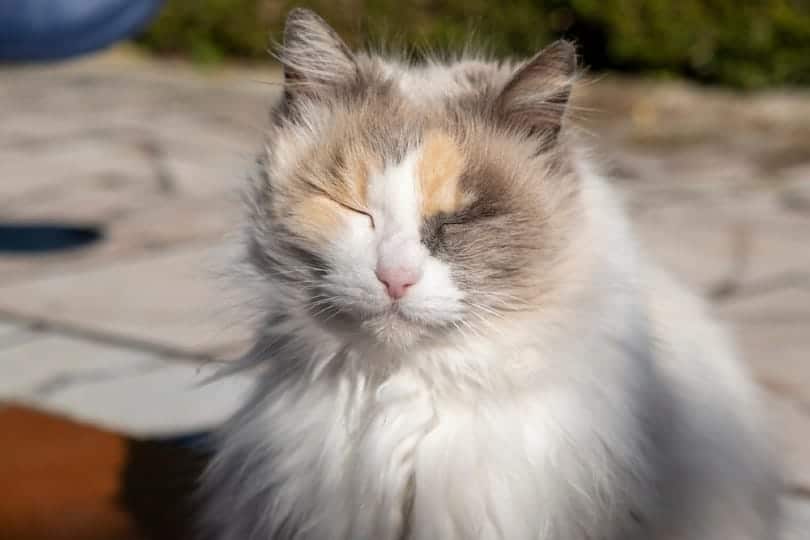
A dilute calico cat will have a white coat with patches of cream and blue. Their feet, legs, chest, muzzle, and stomach should all be white. An inverted “V” blaze on their faces is preferable for cats that will be shown competitively.
40. Blue-Cream Norwegian Forest Cat
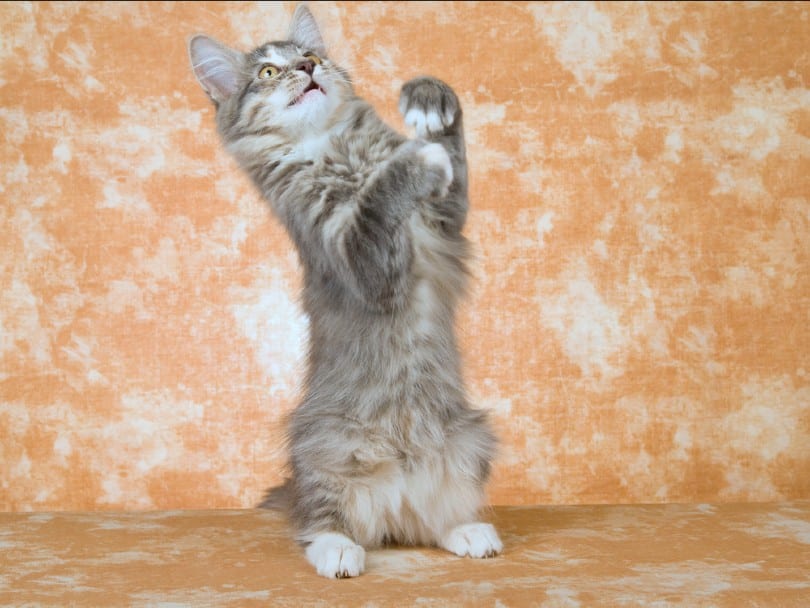
A blue-cream Norwegian Forest Cat has a blue body with patches of solid cream. These patches should be clearly defined and cover both their body and extremities.
41. Bi-Color Norwegian Forest Cat
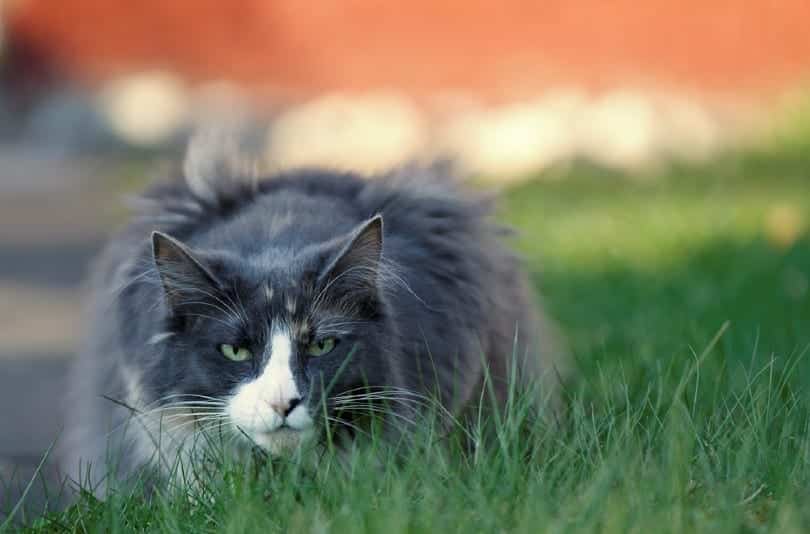
A bi-color Norwegian Forest Cat will have a coat comprising two different colors. These can be any combination of black and white, blue and white, red and white, or cream and white.
42. Van Bi-Color Norwegian Forest Cat
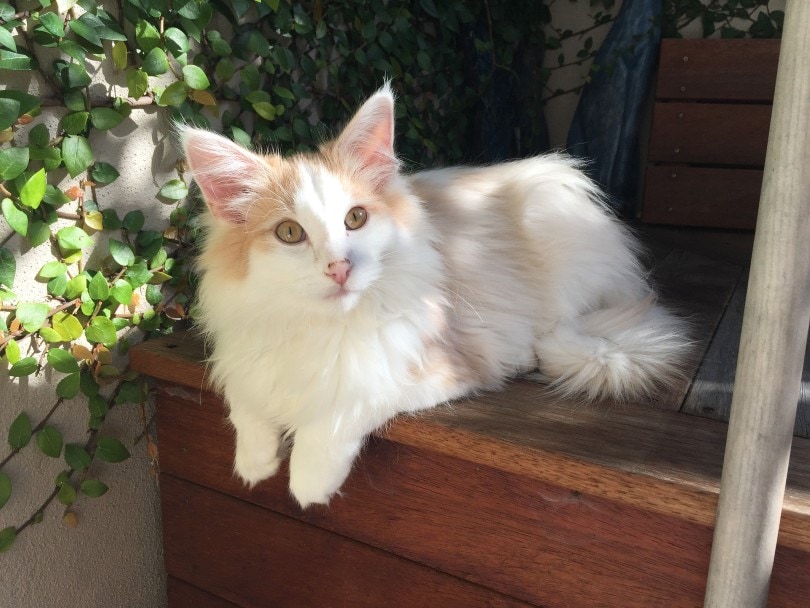
A van bi-color Norwegian Forest Cat has a white coat, with patches of one other color over their head, tail, and legs. Their body should be mostly white, but one or two small patches of color are allowed. They can be any combination of black and white, blue and white, red and white, or cream and white.
43. Van Calico Norwegian Forest Cat

A van calico has white fur with unbridled patches of red and black on their legs, tail, and head. A couple of small areas of color on the body are allowed, but a white body is preferred.
44. Van Dilute Calico Norwegian Forest Cat
A van dilute calico Norwegian Forest Cat has a white body, with patches of blue and cream on their head, tail, and legs. A small number of colored spots on their body is allowed. For any of the van colors, if they have more than two small body spots, a cat should be shown in the corresponding bi-color class instead.
45. Tabby and White Norwegian Forest Cat
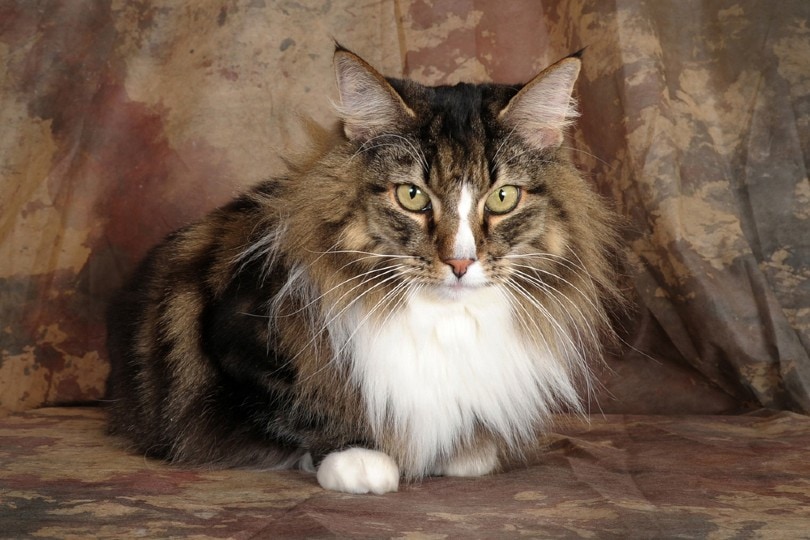
A tabby and white Norwegian Forest Cat will have patches of tabby and white. The tabby areas should follow the color standard set out for that shade and pattern.
46. Smoke, Shaded, Shell, and White Norwegian Forest Cat
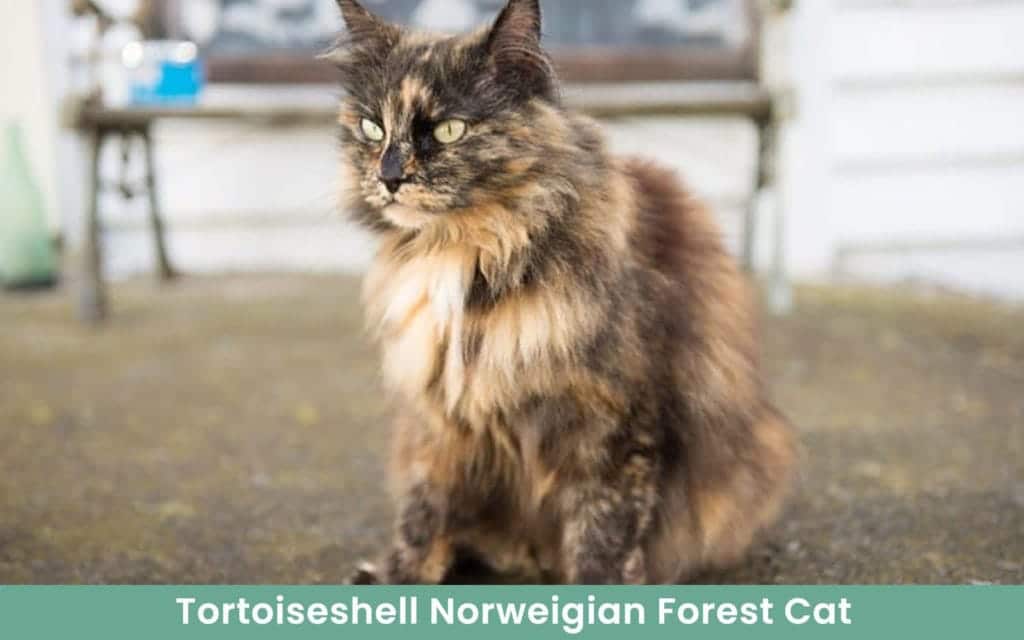
Norwegian Forest Cats in the smoke, shaded, or shell and white category will have white portions and colored portions in either smoke, shaded, or shell patterns. The colored sections should match the description for their particular shade.
47. Tortoiseshell and White Norwegian Forest Cat
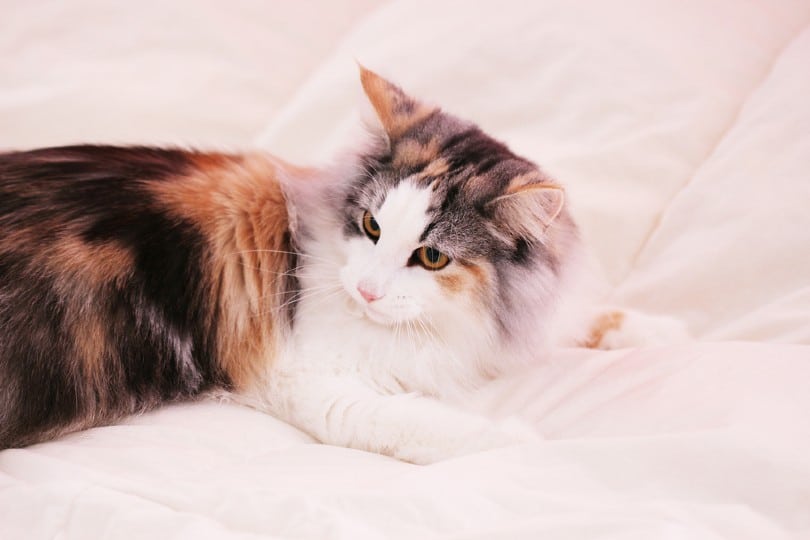
These Norwegian Forest Cats have patches of both tortoiseshell and white, with the tortoiseshell areas being black interspersed with patches of red, which can be several different shades.
48. Blue-Cream and White Norwegian Forest Cat
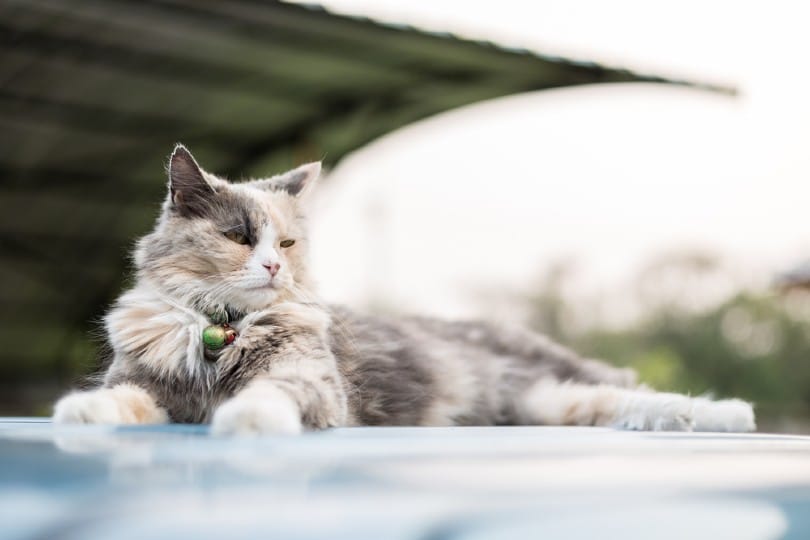
A blue-cream and white Norwegian Forest Cat has sections of white and blue-cream. The blue-cream areas should match the color description for that shade.
49. Amber Norwegian Forest Cat
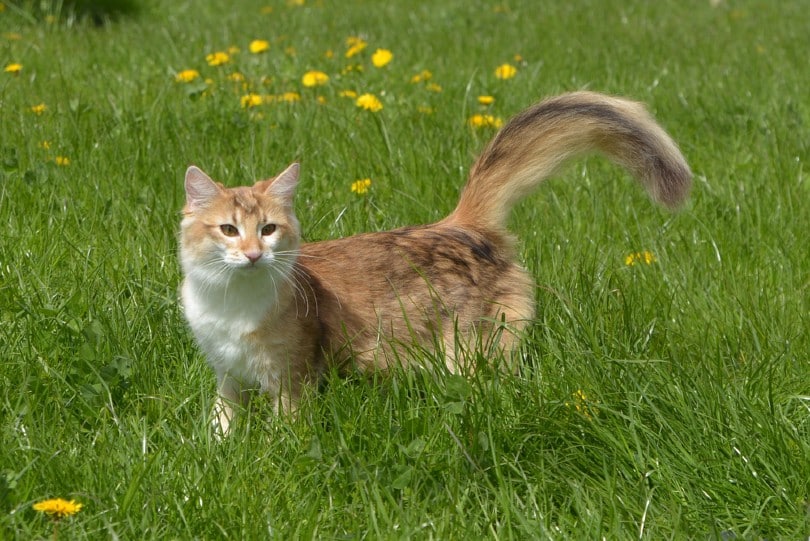
Amber is a recessive, non-agouti color that is genetically yellow but presents as a dark honey-chestnut shade. Kittens are usually born a warm brown color, and the amber shade will become visible as they mature. Some have ghost tabby markings. An amber Norwegian Forest Cat has nose leather and paw pads of a dark brown to charcoal black. Any amber color can also be combined with white patches.
50. Amber Smoke Norwegian Forest Cat
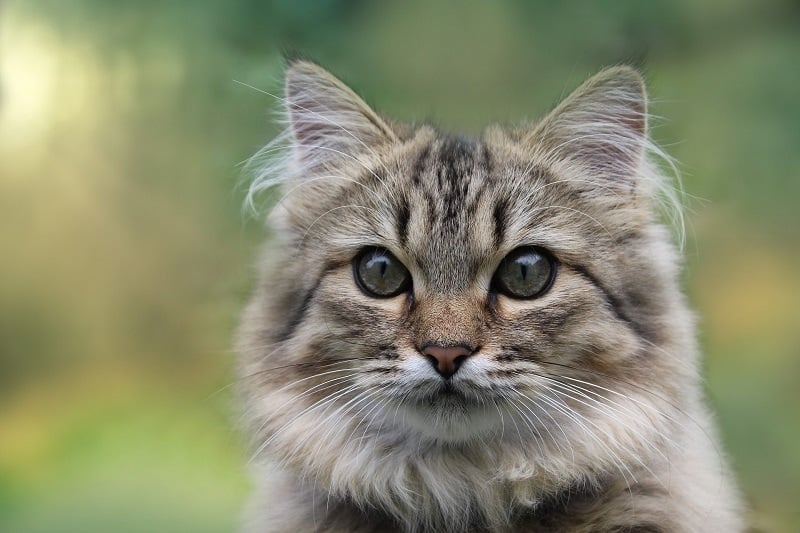
An amber smoke Norwegian Forest Cat will have a white undercoat with deeply tipped amber ends. Their legs, tail, and face will all be amber, with a narrow white band seen at the root of the fur. This should only be visible when their fur is parted.
51. Light Amber Smoke Norwegian Forest Cat

A light amber smoke Norwegian Forest Cat has a white undercoat that is deeply tipped with a light amber color. Their face, tail, and legs will all be pale amber, with a narrow band of white fur at the base. This should only be seen when their fur is parted.
52. Amber Tabby Norwegian Forest Cat
Amber tabby Norwegian Forest Cats have a warm amber ground color with tabby markings in a richer, darker shade of amber. Kittens look similar to warm brown tabbies, and their amber color becomes more evident as they mature. Pink nose leather is preferable. Paw pads are usually pink but change to brown or black with age.
53. Light Amber Tabby Norwegian Forest Cat
A light amber tabby will have a ground color of a pale beige blonde. Their markings will be a darker tone of the same shade and can be any one of the four accepted tabby patterns. Kittens initially look like blue tabbies, and their color will change as they age. Nose leather should be pink, as will the paw pads, although these should change to blue as the cat reaches maturity.
54. Amber Tortoiseshell Norwegian Forest Cat
An amber tortoiseshell Norwegian Forest Cat has an amber body with patches of red, of which there can be more than one shade. Amber tortoiseshell kittens appear black, red, or dark brown, with the black areas of their coat fading to amber as they mature.
55. Amber Tortoiseshell Smoke Norwegian Forest Cat
This color of Norwegian Forest Cat has a white undercoat that can only be seen when their fur is parted. The ground color will be amber with red patches, which can have soft or hard edges. It’s possible to see more than one shade of red on one cat! Kittens of this color are born looking black, dark red, or brown. The black areas will gradually turn amber, and their undercoat will fade to white.
56. Amber Patched Tabby Norwegian Forest Cat
Amber patched tabby Norwegian Forest Cats have a ground coat color of a dark and rich honey chestnut. Their tabby markings will be dark enough to show a good amount of contrast and can be classic, mackerel, spotted, or ticked. They will also have patches of red or cream, clearly defined across their bodies and extremities. For show cats, preference will be given to those with a blaze of red or cream down the face.
57. Light Amber Patched Tabby Norwegian Forest Cat
A light amber patched tabby Norwegian Forest Cat will have a pale beige to blonde ground color with tabby markings in a darker shade but with the same tone. This will be interspersed with patches of cream on both the body and extremities. A cream blaze on the face is also desirable. Their tabby pattern can be any of the four tabby markings.
58. Amber Silver Tabby Norwegian Forest Cat
An amber silver tabby Norwegian Forest Cat has a silver ground color and a white undercoat. Their tabby markings will be a dark honey chestnut shade and can be either classic, mackerel, spotted, or ticked.
59. Light Amber Silver Tabby Norwegian Forest Cat
Light amber silver tabbies can be found in any of the four tabby patterns. The ground color of these cats is pale silver with a white undercoat. The tabby markings will be beige blonde and show a good level of contrast between the pale silver base.
60. Any Other Norwegian Forest Cat Colors
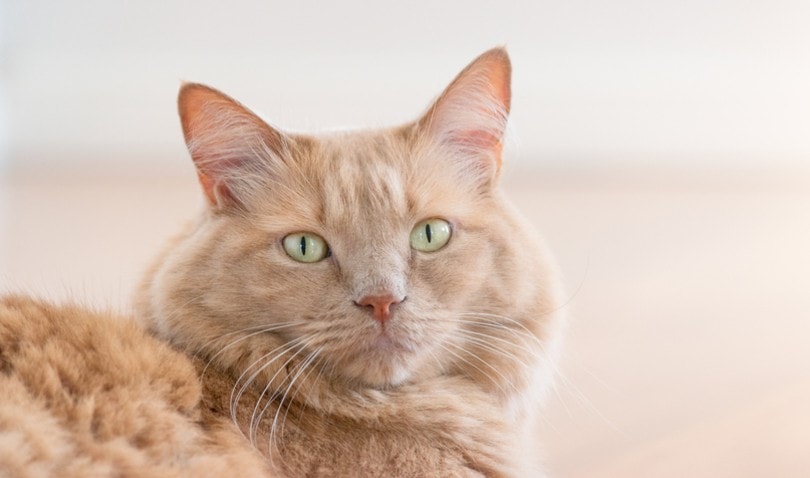
Last but not least, we have the catch-all category of “any other.” This includes any other pattern or color, except for specific colors that point toward crossing with another breed. The excluded colors include chocolate, cinnamon, sable, fawn, lilac, lavender, or the Himalayan pointed pattern. Any of these colors mixed with white patches are also not accepted by the CFA breed standard.
Conclusion
There we have it: the 60 colors and patterns of the Norwegian Forest Cat! If you love these huge felines and would like one of your own, we recommend communicating with rescue organizations or local shelters before trying to find a breeder. You may not get the exact color you want, but you’re sure to get a loving kitty companion that will liven up your household.
Related Reads:
Featured Image Credit by: Elisa Putti, Shutterstock

